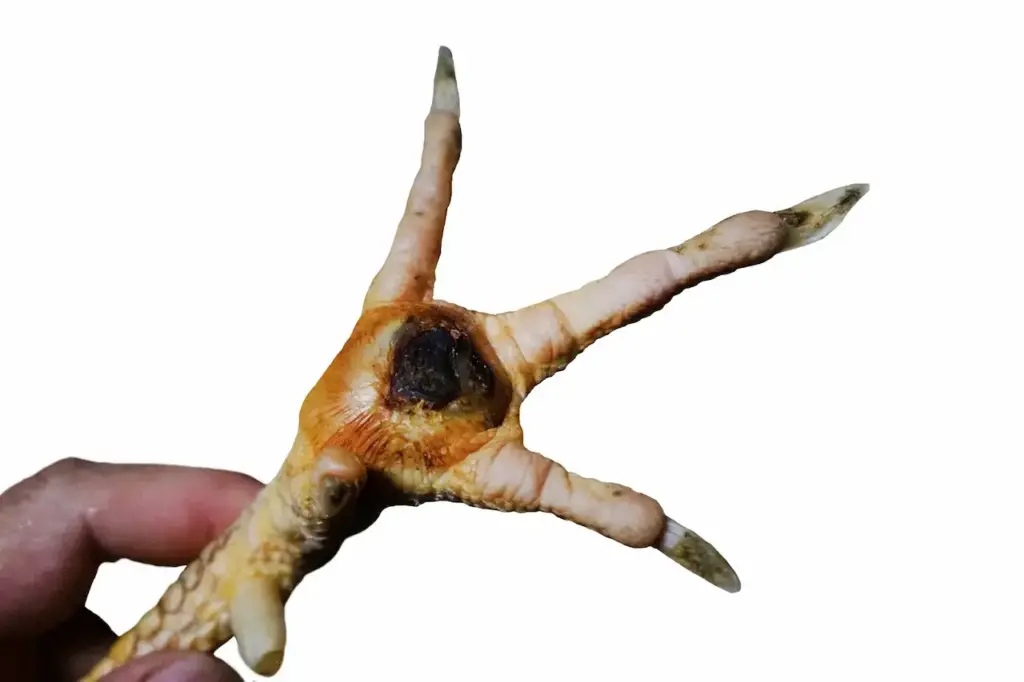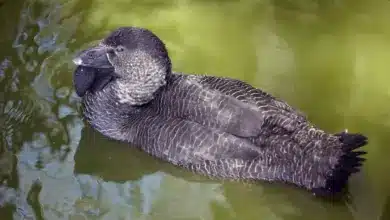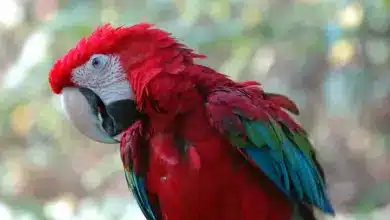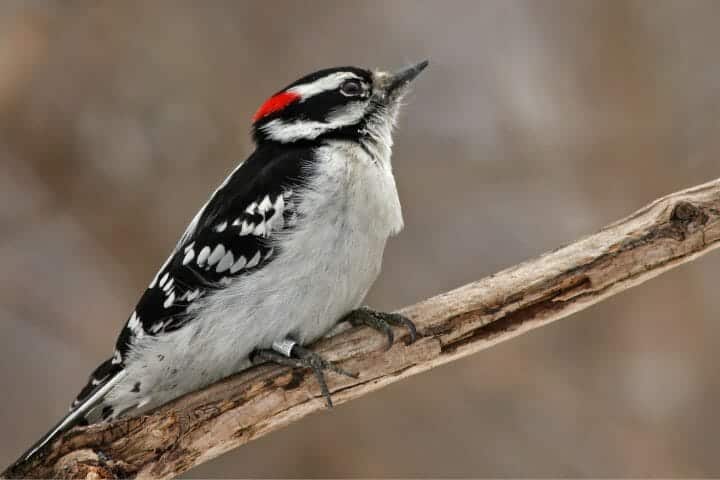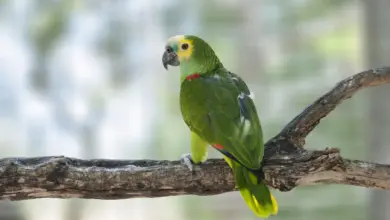Bumblefoot, also known as pododermatitis, is a bacterial infection of the foot that affects birds. It causes swelling, lesions, and abscesses on the bottom of the foot. Bumblefoot can range in severity from mild to life-threatening if left untreated.
It is seen in both wild birds and captive pet birds. Understanding the causes, symptoms, diagnosis, and treatment options for bumblefoot is important for bird health.
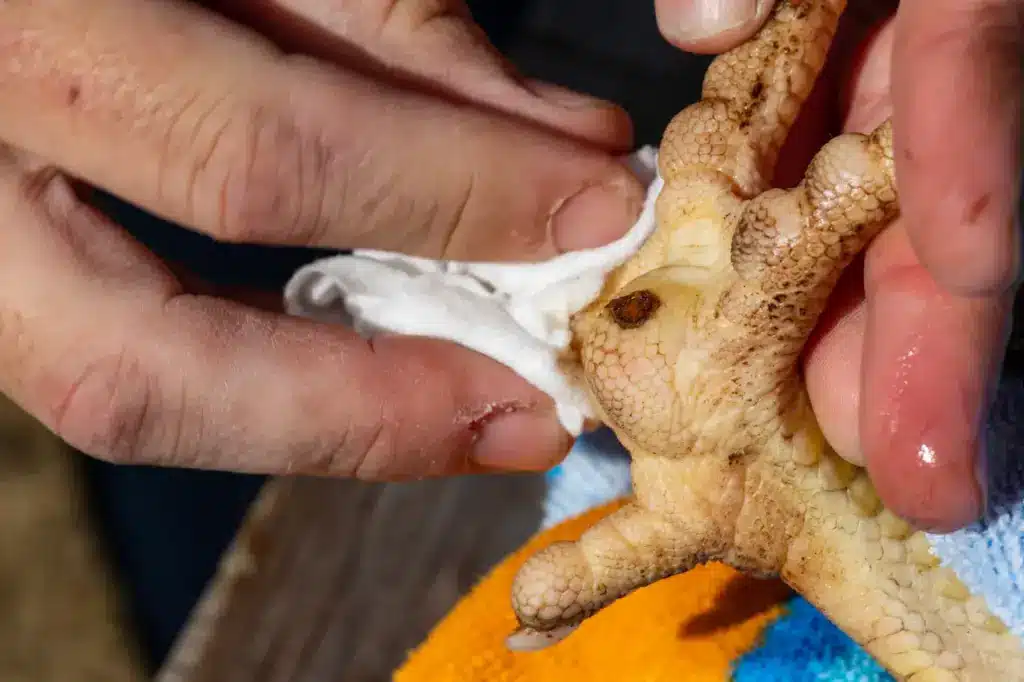
Causes of bumblefoot
Several potential causes can contribute to bumblefoot in birds, especially chickens and ducks.
Injury
Even minor injuries to the foot, such as scratches, abrasions, or puncture wounds, can allow bacteria to enter the tissue and the bloodstream and cause an infection. These injuries compromise the protective barrier of the skin.
Injuries frequently occur in captivity from bird wire cage bottoms, perches, toys, or substrates if improper. Wild birds can suffer foot injuries from sharp branches, thorns, or debris they land on.
Pressure Sores
Constant pressure on the foot from improper perching or standing too long on hard surfaces can damage the skin and lead to lesion development. Irritation from pressure can cause inflammation and cracking that allows bacteria in.
Obese birds or those with foot deformities are at higher risk as more pressure is put on their feet. Ingrown or overgrown nails also create localized pressure points and tissue damage.
Unsanitary Conditions
Dirty cage floors, perches, or bedding allow bacteria such as Staphylococcus to readily colonize the skin and proliferate. Wet conditions from spilled water or bathing can also encourage bacterial growth and penetration into the skin.
Feces contamination is another common source of bacterial infection, especially from E. coli and other gram-negative bacteria in droppings.
Nutritional Deficiencies
Diets deficient in nutrients like vitamin A, vitamin D, calcium, or magnesium are associated with increased foot problems and bird infections.
These deficiencies make them more vulnerable to damage and slower to heal from infections. Vitamins A and D are essential for skin and tissue health and immune function.
Compromised Immunity
Birds that are stressed, undergoing hormonal changes like molting, or have pre-existing illnesses may have weakened immune systems that make them prone to bacterial infection and bumblefoot.
Older birds are also at increased risk as their immune function declines naturally with age. Any compromise to immunity allows bacteria to gain a foothold.
Symptoms of bumblefoot
bumblefoot initially causes swelling, reddening, and inflammation on the bottom of the foot. As it progresses, symptoms may worsen to:
- Callus or blister-like lesions
- Nodules or lumps on the foot pad as infection spreads
- Black scabs from dried exudate and necrosis
- Draining abscesses as infection forms pockets
- Loss of scales and deterioration of skin
- Irritation, itching, discomfort
- Lameness, difficulty perching due to pain
In severe untreated cases, the infection can spread to the bones and joints of the foot. Birds will favor the uninfected foot, which can lead to overuse injuries and arthritis in that foot over time. Appetite loss and lethargy may be seen if the infection disseminates into the bloodstream, causing sepsis.
Diagnosis of bumblefoot
A veterinarian can diagnose bumblefoot through a physical exam of the foot – looking for swelling, skin lesions, and pain on palpation. They will also take samples for bacterial culture to identify the infecting organism and its antibiotic sensitivities.
Radiographs may reveal bone involvement, foreign bodies, or bone deterioration. Blood work helps evaluate any associated illness or systemic effects like organ issues.
The avian specialist veterinarian will grade the lesion based on severity to guide treatment.
Mild cases show only minor swelling and inflammation. Moderate bumblefoot has significant nodules, scarring, and tissue damage. Severe cases involve deeply seeded abscesses, bone, and joint infection. Differentiating between mild surface lesions versus severe deep tissue infection is essential for prognosis and treatment planning.
Treatment Options for bumblefoot
Several treatment options are available depending on bumblefoot severity:
Topical Medications
For mild surface infections, topical antibiotics, antiseptics like Betadine, silver sulfadiazine ointments, or Epsom salt soaks may be used. These help clear bacteria and reduce inflammation on the skin’s surface. Bandages can protect the lesions from further damage.

Oral Antibiotics
For deeper tissue infections, oral or injectable antibiotic therapy is needed. Antibiotics like amoxicillin, enrofloxacin, or trimethoprim-sulfa can penetrate inflamed tissues better. Antibiotics are given for 3-6 weeks, along with topical therapy. Culture and sensitivity guide antibiotic choice.
Lancing and Flushing
Abscesses need to be lanced, drained, and flushed out by a vet to remove necrotic material and infection pockets. This allows continued drainage. Topical and oral antibiotics are still needed after lancing and debridement.
Surgery
Severe bumblefoot with extensive bone involvement may require partial surgical resection of infected bone tissue. This is followed by intensive wound management and antibiotics. In the most severe cases with joint infection or gangrene, partial amputation of the foot/toes may be needed.
Remove Predisposing Factors
It’s critical to correct any contributing factors like obesity, nutritional deficiencies, unsanitary housing, or injury sources. Providing proper perches, clean substrate, and a balanced diet helps manage bumblefoot long term.
Supportive Care
Ensuring adequate nutrition and hydration supports the immune response and aids recovery. Vitamin supplements also support healing. Pain medication may be prescribed as needed for comfort. Elizabethan collars prevent self-mutilation of lesions.
Follow up Care
Bandage changes, repeat bacterial testing, monitoring for recurrence, and owner compliance with medications require follow-up vet appointments until the infection resolves fully. This can take months for chronic cases. Lifelong maintenance may be required if deformities remain.
Prevention of bumblefoot
Preventing bumblefoot is much easier than treating it. Recommended prevention measures include:
- Avoid wire or abrasive cage floors
- Provide a variety of perch sizes and textures
- Keep feeders, toys, and perches clean
- Disinfect cages/aviaries regularly to prevent bacterial buildup
- Use smooth, easy-to-clean substrates
- Maintain proper nutrition and weight to support immune function
- Avoid overgrown nails or foot deformities that cause pressure
- Keep birds stress-free and active for good circulation
Annual vet exams allow early identification and treatment of any foot problems before they become infected. Being proactive helps avoid this painful and potentially life-threatening bird disease. Bumblefoot can usually be prevented in captive birds with reasonable care and hygiene. Wild birds benefit from clean feeders and birdbaths as well to prevent transmission.
Educating Bird Owners and Caretakers
It is important to educate bird owners, breeders, and avian specialists about bumblefoot to raise awareness and prevent infections.
Providing informational resources on proper cage setup, perch type, hygiene practices, nutrition, and regular vet checks enables proactive care.
Training on recognizing early signs of swelling, lesions, or scabs allows for quicker veterinary treatment before the infection worsens.
Open communication channels like forums, newsletters, and avian conferences also help disseminate knowledge on bumblefoot prevention and care within the bird enthusiast community.
Conclusion
bumblefoot is a common bacterial infection of the foot seen in pets and wild birds. It is caused by injury, unsanitary conditions, nutritional deficiencies, and other stresses that lower immunity against bacteria.
Diagnosis involves clinical exams, culturing, and radiographs to assess severity. Treatment ranges from topical therapy to extensive surgery and amputation in the worst cases.
Prevention through proper housing hygiene, nutrition, and veterinary care is highly effective. Being vigilant for early swelling or calluses allows early treatment. Providing clean environments, a balanced diet, and regular check-ups are key to preventing this uncomfortable, debilitating foot disease in birds.

